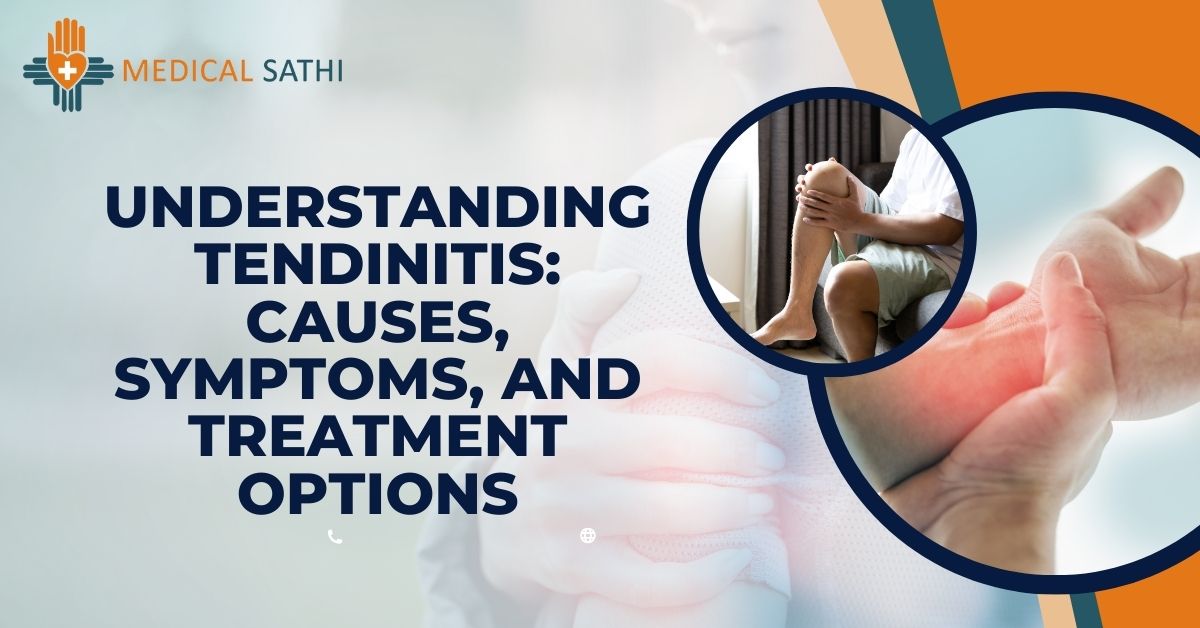Understanding Tendinitis: Causes, Symptoms, And Treatment Options
Tendinitis is a common condition that causes inflammation in the tendons, the tough bands that connect muscles to bones. It's a pain many of us experience at some point, especially if our activities involve repetitive movements. But fear not, tendinitis is usually treatable, and with a little understanding and care, you can get back to doing what you love.
This blog delves into the world of tendinitis, exploring its causes, symptoms, and various treatment options. We'll also discuss ways to prevent this pesky condition from taking hold in the first place
What Exactly is Tendinitis?
Imagine a network of cables connecting your muscles to bones – that's essentially what tendons are. When these cables become overloaded or irritated, they get inflamed, leading to pain and tenderness. This inflammation is what we call tendinitis.
What Triggers Tendinitis?

There are several culprits behind tendinitis, with the most common being:
Overuse: Repetitive motions put excessive stress on tendons, leading to inflammation. This can be anything from throwing a baseball to spending hours typing on a keyboard.
Improper Technique: Not using the correct form during exercise or activities can put undue strain on tendons.
Age: As we age, our tendons naturally lose some elasticity, making them more susceptible to injury.
Certain Medical Conditions: Conditions like rheumatoid arthritis can contribute to tendinitis.
Certain Medications: Some antibiotics can increase the risk of tendinitis.
Recognize the Signs: Symptoms of Tendinitis
Tendinitis often announces its presence quite clearly. Here's what to watch out for:
Pain: This is often the first line of defense. Give the inflamed tendon time to heal by reducing activities that aggravate the pain.
Tenderness: Touching the inflamed area will likely cause discomfort.
Stiffness: The affected joint might feel stiff, especially in the mornings or after periods of inactivity..
Weakness: You might experience weakness in the muscles connected to the inflamed tendon.
Reduced Range of Motion: Moving the affected joint through its full range of motion may become difficult or painful.
Combating the Discomfort:Treatment Options for Tendinitis
The good news is that tendinitis is usually treatable. Here are some common approaches:
Rest:This is often the first line of defense. Give the inflamed tendon time to heal by reducing activities that aggravate the pain.
Tenderness: Touching the inflamed area will likely cause discomfort.
Ice: Applying ice packs to the affected area for 15-20 minutes at a time, several times a day, can help reduce inflammation and pain.
Pain Relievers: Over-the-counter pain relievers like ibuprofen or acetaminophen can help manage discomfort
Physical Therapy: Exercises prescribed by a physical therapist can help strengthen the muscles around the joint, improve flexibility, and prevent future injuries.
Corticosteroid Injections: In some cases, a doctor might inject a corticosteroid medication directly into the inflamed area to reduce inflammation.
Surgery: Surgery is rarely needed for tendinitis but might be an option in severe cases that don't respond to other treatments.
Preventing Tendinitis: Keeping Your Tendons Happy

Here are some tips to keep those tendons healthy and pain-free:
Warm Up and Cool Down: Before any activity that involves repetitive movements, take some time to warm up your muscles with light stretches. Similarly, cool down with gentle stretches after the activity.
Maintain Proper Form: Whether you're playing sports, lifting weights, or even working at a desk, ensure you're using the correct form to avoid putting undue stress on your tendons.
Listen to Your Body: Pain is a signal that something's wrong. Don't push through the pain – take a break when needed.
Strengthen Your Muscles: Stronger muscles can better support your joints and take stress off your tendons. Engage in exercises that target the muscles around the joints susceptible to tendinitis.
Maintain a Healthy Weight: Excess weight puts extra strain on your joints and tendons.
Conclusion
Understanding tendinitis and its underlying causes empowers you to take control of your well-being. By recognizing the symptoms and taking proactive steps toward treatment and prevention, you can keep your tendons happy and healthy.
If you're experiencing persistent pain or suspect tendinitis, don't hesitate to seek professional guidance. Mеdical Sathi, a platform dedicated to connecting patients with qualified healthcare providers, can help you find a trusted Orthopedic Doctor in Faridabad. With their expertise, you can create a personalized treatment plan to address your specific needs and get back to living an active, pain-free life. Schedule your consultation today and take the first step towards optimal tendon health!
